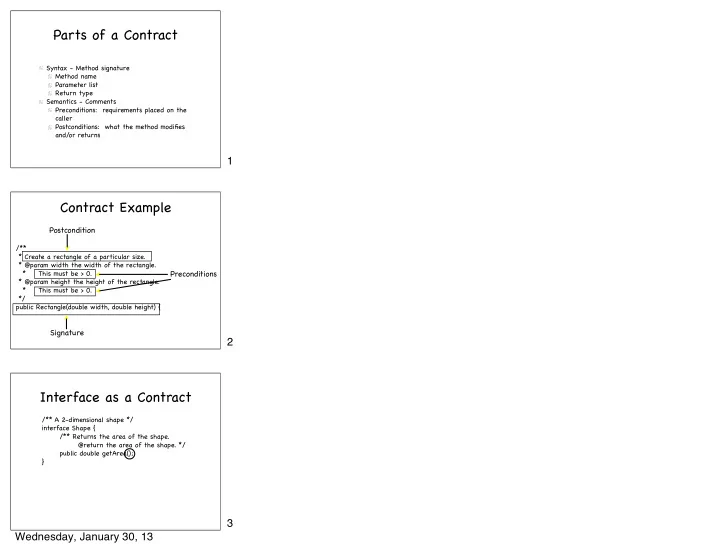

Parts of a Contract Syntax - Method signature Method name Parameter list Return type Semantics - Comments Preconditions: requirements placed on the caller Postconditions: what the method modifies and/or returns 1 Contract Example Postcondition � /** � * Create a rectangle of a particular size. � * @param width the width of the rectangle. * This must be > 0. Preconditions � * @param height the height of the rectangle. * This must be > 0. � */ � public Rectangle(double width, double height) { Signature 2 Interface as a Contract /** A 2-dimensional shape */ interface Shape { /** Returns the area of the shape. @return the area of the shape. */ public double getArea(); } 3 Wednesday, January 30, 13
The Supplier Side of the Contract public class Rectangle implements Shape { private double width; private double height; public Rectangle(double width, double height) { this.width = width; this.height = height; } Must define this public double getArea() { to satisfy the return width*height; contract. } } 4 The Client Side of the Contract Can use interface names as types Shape someShape; someShape = new Rectangle (3, 5); double area = someShape.getArea(); Can assign instance of implementing classes to variables declared with interface types 5 The Client Side of the Contract Shape someShape; someShape = new Rectangle (3, 5); double area = someShape.getArea(); Can call methods declared in the interface. 6 Wednesday, January 30, 13
Polymorphism public class ShapeArray { � private Shape[] shapes = new Shape[10]; � private int nextIndex = 0; � � public void addShape (Shape newShape) { � � if (nextIndex < shapes.length) { Which entries in � � � shapes[nextIndex] = newShape; � � � nextIndex++; the array are � � } circles??? � } � � public double getArea (int index) { � � if (index >= 0 && index < nextIndex) { � � � return shapes[index].getArea(); � � } � � return -1; � } } 7 Swing Package used to create Graphical User Interfaces (GUIs) in Java JButton JComboBox JCheckBox JSlider JTextField JLabel 8 Displaying Buttons in Swing Construct a JButton, passing in its label JButton click = new JButton (“Click me!”); Add the button to a panel JPanel buttonPanel = new JPanel(); buttonPanel.add (click); Add the panel to the display, no need to specify size or exact location getContentPane().add (buttonPanel, BorderLayout.CENTER); 9 Wednesday, January 30, 13
ActionListener Interface public interface ActionListener { public void actionPerformed (ActionEvent e); } actionPerformed is the method that Java calls when the user clicks on a JButton. To handle button clicks, you must do 3 things: Have your class “implement ActionListener” Define the actionPerformed method Attach your ActionListener object to the JButton: myButton.addActionListener (this); 10 ActionListener Contract 11 Handling Button Clicks Tell Java where to find the event handler click.addActionListener (this); Define the event handler public class ClickMe implements ActionListener public void actionPerformed (ActionEvent event) { counter++; counterLabel.setText("" + counter); } 12 Wednesday, January 30, 13
ActionListener Contract Your side of the contract: Attach a listener to your button “implement ActionListener” Define the actionPerformed method Java’ s side of the contract: Java will call your actionPerformed method when the user clicks the button. 13 Swing Events Every event handling method has a parameter describing the event that occurred. The most useful method for us is: public Object getSource() This returns the Swing component that the user interacted with. Useful if an event handling method handles events for more than 1 object. 14 BorderLayout Rules One component per compass point Component expands to fill the entire area 15 Wednesday, January 30, 13
BorderLayout NORTH WEST EAST SOUTH BorderLayout lays out components using compass directions + CENTER Default for a JFrame’ s content pane. 16 What Gives??? EAST There are 2 buttons in the EAST! The buttons do not fill the entire east area! Conclusion: My professor lied to me! 17 More on “add”ing components Adding a button to a panel: JPanel buttonPanel = new JPanel(); buttonPanel.add (clickButton); ➡ JPanel lays out its components like words on a page Adding a panel to the frame: getContentPane().add (buttonPanel, BorderLayout.CENTER); ➡ contentPane lays out its components using compass directions: NORTH, SOUTH, EAST, WEST and CENTER 18 Wednesday, January 30, 13
Grouping Components with JPanel JPanel buttonPanel = new JPanel(); buttonPanel.add (new JButton("Place order")); buttonPanel.add (new JButton("Cancel order")); contentPane.add(buttonPanel, BorderLayout.EAST); 19 FlowLayout A JPanel uses FlowLayout as its layout manager rather than BorderLayout. With BorderLayout, we say: contentPane.add (buttonPanel, BorderLayout.SOUTH); With FlowLayout, we omit the compass direction: buttonPanel.add(orderButton); Components are added from left to right. 20 FlowLayout There are 2 buttons in the button panel. buttonPanel.add (orderButton); There is 1 button panel in the EAST. buttonPanel.add (cancelButton); FlowLayout sizes components in a more natural way. Conclusion: My professor didn’ t lie to me! 21 Wednesday, January 30, 13
JPanel gives “natural” size contentPane.add(comboBox, BorderLayout.SOUTH); toppingsPanel.add (comboBox); contentPane.add(toppingsPanel, BorderLayout.SOUTH); 22 Wednesday, January 30, 13
Recommend
More recommend